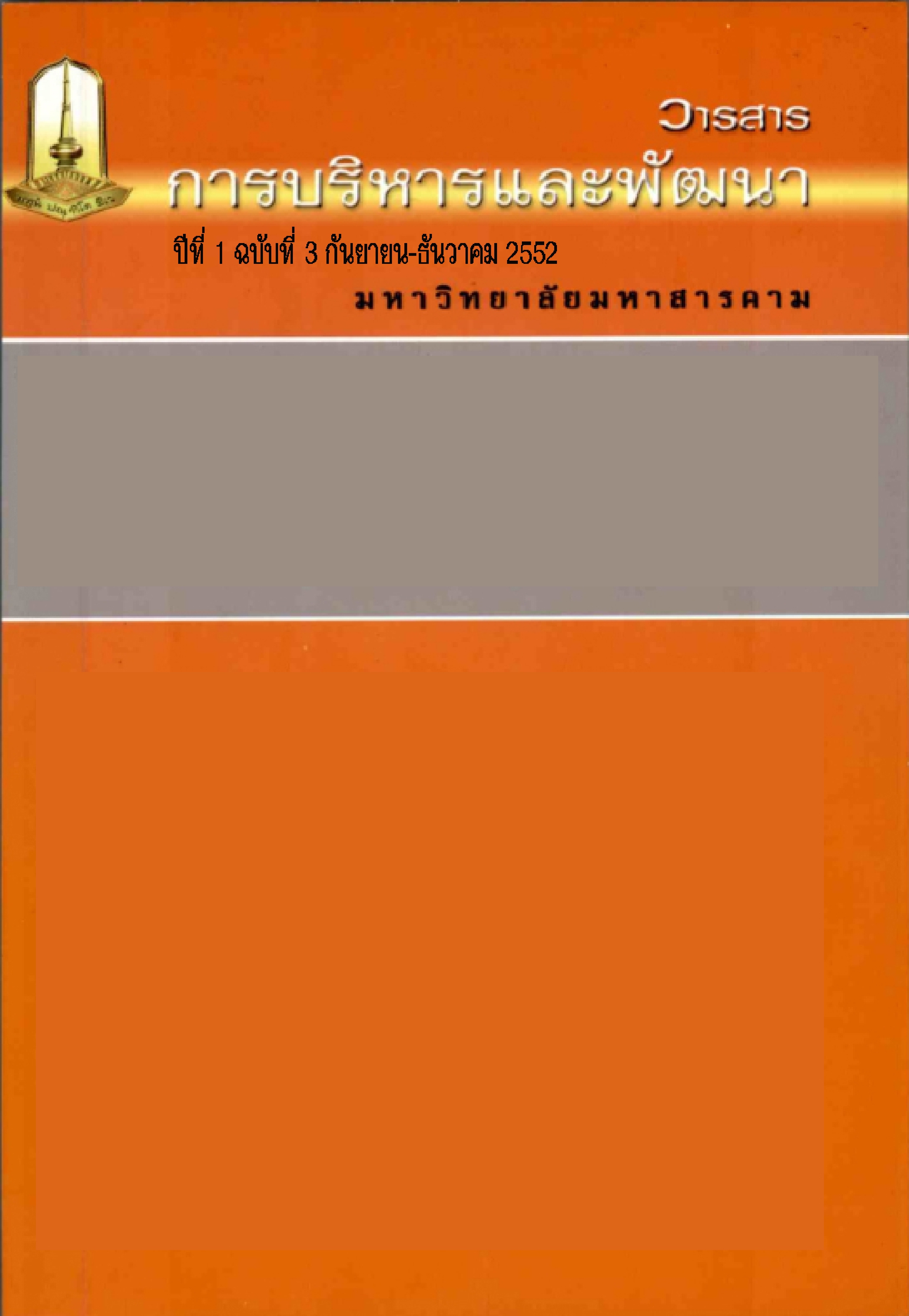Comparisons of Effective of Learning on Equation and Solving of Equation by Courseware and by Traditional Method Learning Outcomes for Prathomsueksa 6 Students within Cooperative Learning Context
Main Article Content
Abstract
The purposes of this study were : (1) to develop a courseware on “Equation and Solving of Equation” with a required efficiency of 75/75, (2) to find out an effectiveness index of the develop courseware, (3) to compare learning achievement and learning mathematical problem solving skills by courseware and traditional method within cooperative learning context, and (4) to study students’satisfaction with the develop courseware. The sample used in this study consisted of 60 students selected by the purposive sampling technique from two classroom of Nongyaiwittaya School in Amphoe Nongkungsri under the Office of Kalasin Educational Service Area Zone 2 in the first semester of the academic year 2009. The students were divided through the Simple random sampling technique into two groups : the experimental group learned using courseware and the control group learned using traditional method. The instruments used in this study included ; (1) a courseware on “Equation and Solving of Equation” for Prathomsuksa 6, (2) learning plans for the control group, (3) the learning achievement test on “Equation and Solving of Equation”, (4) the learning mathematical problem solving skills test on “Equation and Solving of Equation”, and (5) the questionnaire on students’ satisfaction with learning through the developed courseware. The statistics used for analyzing data were percentage, mean, and standard deviation: t-test was employed for testing hypotheses.
The results of the study were as follows :1. The developed courseware on “Equation and Solving of Equation” for Prathomsuksa 6 showed an efficiency of 82.96/78.58
2. The developed courseware on “Equation and Solving of Equation” for Prathomsuksa 6 showed an effectiveness of .6344 show that the students progressed their learning at 63.44
3. The students learning using courseware and the students learning using the traditional method showed learning achievement differently (P < .05). However, the students learned using the courseware indicated more learning retention than the other students at the .05 level of significance.
4. The students learning using courseware and the students learning using the traditional method showed learning mathematical problem solving skills differently (P< .05). However, the students learned using the courseware indicated more learning retention than the other students at the .05 level of significance.
5. The students showed their satisfaction with learning through the courseware as a whole at a more level. In conclusion, the developed courseware on “Equation and Solving of Equation” for Prathomsuksa 6 were appropriately efficient, effective and mathematical problem solving skills. It could be implemented in learning and teaching in order to facilitate to achieve the expected objective of the course.
Downloads
Article Details
References
ครรชิต มาลัยวงค์. (2540). ทัศนะไอที. กรุงเทพฯ : ซีเอ็ดยูเคชั่น.
จันทร์ฉาย เตมิยาคาร. (2537). เอกสารประกอบคำสอนประจำ วิชา 059759 คอมพิวเตอร์ขั้นสูงกับการศึกษา. เชียงใหม่ : ภาควิชาเทคโนโลยีทางการศึกษา คณะศึกษาศาสตร์ มหาวิทยาลัยเชียงใหม่.
จิราภรณ์ นามมะ. (2548). การเปรียบเทียบผลการเรียนรู้ เรื่อง จำนวนนับ กลุ่มสาระการเรียนรู้คณิตศาสตร์ชั้นประถมศึกษาปีที่ 6 ระหว่างการเรียนด้วยบทเรียนคอมพิวเตอร์กับการเรียนที่เน้นทักษะกระบวนการทางคณิตศาสตร์ โรงเรียนบ้านดู่ และโรงเรียนบ้านโนนสวรรค์. วิทยานิพนธ์ กศ.ม. มหาสารคาม :มหาวิทยาลัยมหาสารคาม.
ไชยยศ เรืองสุวรรณ. (2548) .การพัฒนาบทเรียนคอมพิวเตอร์. มหาสารคาม : ภาควิชาเทคโนโลยีและสื่อสารคณะศึกษาศาสตร์ มหาวิทยาลัยมหาสารคาม.
ถนอมพร (ตันพิพัฒน์) เลาหจรัสแสง. (2541) .คอมพิวเตอร์ช่วยสอน. กรุงเทพฯ :ภาควิชาโสตทัศนศึกษา คณะคุรุศาสตร์ จุฬาลงกรณ์มหาวิทยาลัย.
บุญชม ศรีสะอาด. (2545) . การวิจัยเบื้องต้น. พิมพ์ครั้งที่ 7. กรุงเทพฯ : สุวีริยาสาส์น.
พิมพ์ใจ ภิบาลสุข. (2526). “แนวคิดเกี่ยวกับนวัตกรรมทางการศึกษาใประเทศไทย,”วารสารศึกษาศาสตร์ มหาวิทยาลัยขอนแก่น. 8(1) : 1-6 ; มิถุนายน–กันยายน.
สมนึก ภัททิยธนี. (2544). การวัดผลการศึกษา. พิมพ์ครั้งที่ 3. กาฬสินธุ์ : ประสานการพิมพ์.
อรพรรณ พรสีมา. (2530). เทคโนโลยีการศึกษา. กรุงเทพฯ : โอ.เอส. พริ้นติ้งเฮาส์.
Baroody, Arthur. (1993). “Problem Solving , Reasoning, and Communicating , K-8,” Helping Children Thing Mathematically. New York : Macmillan Publish.
Branca , N.A. (1980). “Problem Solving as a Goal , Process, and Basic Skill. In S. Krulik and R.E. Reys (Eds.),” Problem Solving in Schools Mathematics :1980. Yearbook. P. 3-8. Reston, VA : NCTM.


